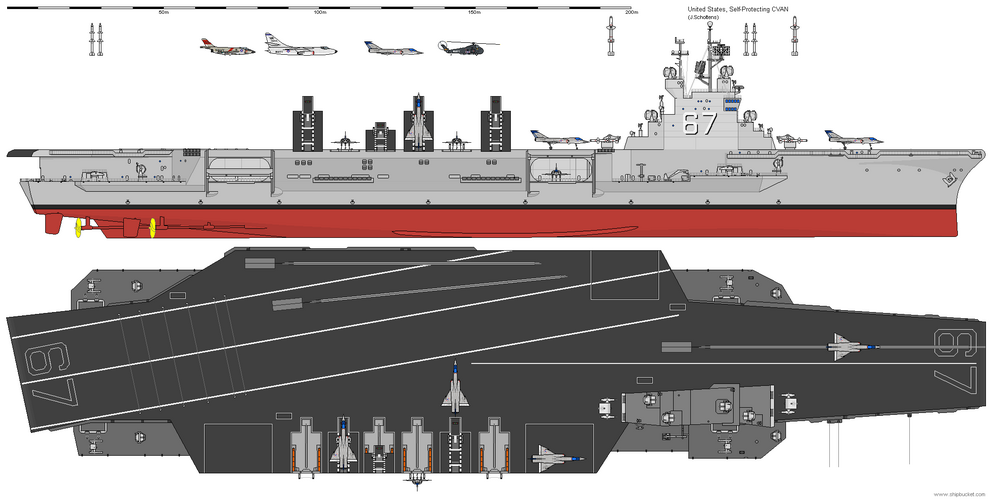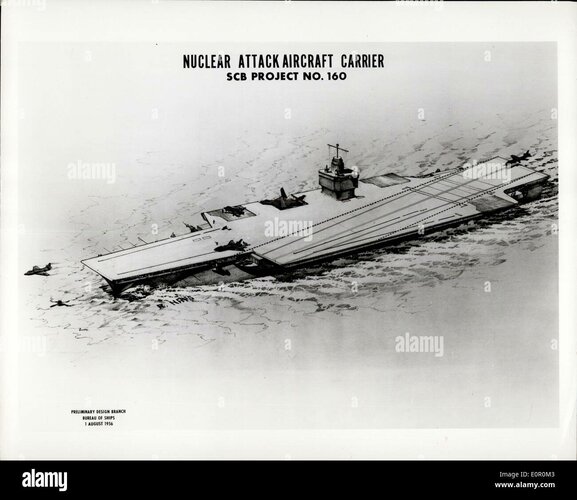One of the earliest indications of navy interest in a nuclear carrier was a 1 August 1950 request by the CN 0, Admiral Forrest Sherman, for a BuShips study of the feasibility of such a ship. Captain H. G. Rick over proposed completion in 1953 of a land-based prototype, the large ship reactor (LSR), and in 1955 of a shipboard plant. So large a plant would have com peted directly with the nuclear weapons program, which used the same highly enriched uranium, so a design study was ordered but no prototype built. However, the Joint Chiefs of Staff did establish a formal requirement for a carrier reactor in Novem ber 1951. At this time the only other naval reactor design in progress was the submarine type that ulti mately powered the Nautilus. A carrier required a very different design, which was assigned in such a way as to preclude merely scaling up the submarine reactor for it. By 1952 the estimated cost of the land based prototype was about $150 million, that is, almost as much as a conventional carrier itself. Given such a high cost, the Joint Chiefs sought to combine in a single plant a prototype land-based power reactor, a plutonium-making reactor, and the naval pro totype.
The new Eisenhower administration was deter mined to cut military costs, just as authorization for the LSR was due. Question was raised within the navy as to the value of a carrier plant. Nuclear power was far easier to justify for a submarine or even for a short-range destroyer; carriers were so large that they could transport a sufficient amount of fuel with them. Moreover, there was some question as to whether the navy could obtain enough nuclear fuel for both a large fleet of submarines and surface ships, a fear particularly legitimate at a time of rapid nu clear-weapon production, with its great drain on national nuclear · resources. Too, there was fear within OPNAV that support for a future nuclear car rier would undermine the existing (and urgent) pro gram of conventional-carrier construction. Admiral Sherman appears to have been the only major naval exponent of the carrier project, and he died in July 1951. Therefore in the summer of 1953 the Atomic Energy Commission (AEC) cancelled the carrier reactor project in favor of one for a land-based power station.
However, the carrier-reactor project did not die. ln May 1954 Rickover proposed a program of five reac tor prototypes, ranging from an attack-submarine power plant up through destroyer, cruiser, and car rier prototypes. The administration approved, and research and development of the carrier-reactor land-based prototype was approved by the AEC in August 1954. By the end of 1955 a land-based pro totype, the Al W, consisting of two reactors driving a simulated single propeller shaft of a carrier, was planned. A frigate reactor, the Fl W, was to use the same core in a somewhat larger reactor, and there was also to be a cruiser plant, the Cl W, using four Al W reactors rather than the eight of the carrier plant. ln these designations the first letter indicated the type of ship, the second the manufacturer (W for Westinghouse and G for General Electric). A two reactor variant of the Cl W powered the nuclear cruiser Lang Beach. ln fact, the Lang Beach plant was used as a seagoing test version of that planned for the Enterprise. No Fl W entered service; instead there were the DI G and D2G destroyer (frigate) reactors. As for carriers, the operational version of the Al W was the A2W; eight reactors of this type powered the first
Both the A2W and Cl W produced similar levels of power. The 280,000 SHP for the Enterprise equates to 35,000 SHP per reactor; the reported 80,000 SHP of the Lang Beach equates to about 40,000 SHP per reactor. The destroyer reactors were somewhat smaller, the Bainbridge showing 60,000 SHPwith two D2Gs, or 30,000 SHP each. By the late fifties indi vidual reactor power was rising, since it appeared that the fewer reactors per ship, the lower the cost per ship would be. An abortive A3W was designed for the four-reactor attack carrier proposed under the FY 61 and FY 63 programs. Since these ships were slower than the Enterprise, one can conclude that the A3W came well short of a quarter of the 280,000-SHP plant, probably about 45,000 to 50,000 SHP. How ever, the pressure for more powerful reactors con tinued strong. ln the early sixties there were attempts to design a single reactor that might replace the 60,000-SHP D2G plant. Although it was not built, experience in its design led directly to the huge A4W, the N imitz plant, which reportedly produces 260,000 SHP (130,000 SHPper reactor). At each level of power some upgrading was possible, but not very much, given the delicacy of reactor design. Thus, for exam ple, any attempt to design a range of nuclear aircraft carriers was very strictly constrained by the range of available reactors. The original Al W/A2W was sized on the hasis of contemporary conventional-carrier power plants, the four-reactor Cl W originally being intended to produce a level of power comparable with that of a Des M aines-class heavy cruiser capable of 120,000 SHP. Ultimately it did rather better on two reactors, which gives some indication of the range of reactor-design flexibility, before details had been fixed.




